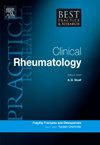儿童抗磷脂综合征
IF 4.8
2区 医学
Q1 RHEUMATOLOGY
Best Practice & Research in Clinical Rheumatology
Pub Date : 2024-09-01
DOI:10.1016/j.berh.2024.101986
引用次数: 0
摘要
儿童抗磷脂综合征(APS)是一种罕见疾病,发病率和死亡率都很高。与成人抗磷脂综合征相比,儿童抗磷脂综合征的表现更为严重,血栓事件频繁复发,发生危及生命的灾难性抗磷脂综合征的概率更高。非血栓性表现在儿科年龄组中也更为常见,并可能先于血栓形成。最近推出了新的分类标准,但尚未对 APS 儿童患者进行评估。除了抗凝药物外,还出现了其他新型疗法,包括使用 B 细胞和补体抑制剂,尤其是在灾难性 APS 中。本综述的目的是在分析已发表的队列和国际儿科 APS 登记数据的基础上,概述儿科患者 APL 相关的临床表现。我们还旨在说明经胎盘转移的母体 aPL 引起的婴儿 APS,这种 APS 在围产期很少与急性血栓事件相关,而更常见的是与长期神经发育异常相关。本文章由计算机程序翻译,如有差异,请以英文原文为准。
Antiphospholipid syndrome in children
Antiphospholipid syndrome (APS) in children is a rare disease associated with significant morbidity and mortality. In comparison with APS in adults, pediatric APS has a more severe presentation with frequent recurrences of thrombotic events and a higher probability of life-threatening catastrophic APS. Nonthrombotic manifestations are also more common in the pediatric age group and can precede thrombosis. New classification criteria have been introduced recently and have not yet been assessed in pediatric patients with APS. In addition to anticoagulation drugs, other novel therapies have emerged including the use of B cell and complement inhibitors, especially in catastrophic APS. The purpose of this review is to provide a broad overview of aPL-related clinical manifestations in pediatric patients based on the analysis of published cohorts and data from the international pediatric APS registry. We also aim to illustrate APS in infants caused by transplacentally transferred maternal aPL, which is very rarely associated with acute thrombotic events in the perinatal period and more frequently with long-term neurodevelopmental abnormalities.
求助全文
通过发布文献求助,成功后即可免费获取论文全文。
去求助
来源期刊
CiteScore
9.40
自引率
0.00%
发文量
43
审稿时长
27 days
期刊介绍:
Evidence-based updates of best clinical practice across the spectrum of musculoskeletal conditions.
Best Practice & Research: Clinical Rheumatology keeps the clinician or trainee informed of the latest developments and current recommended practice in the rapidly advancing fields of musculoskeletal conditions and science.
The series provides a continuous update of current clinical practice. It is a topical serial publication that covers the spectrum of musculoskeletal conditions in a 4-year cycle. Each topic-based issue contains around 200 pages of practical, evidence-based review articles, which integrate the results from the latest original research with current clinical practice and thinking to provide a continuous update.
Each issue follows a problem-orientated approach that focuses on the key questions to be addressed, clearly defining what is known and not known. The review articles seek to address the clinical issues of diagnosis, treatment and patient management. Management is described in practical terms so that it can be applied to the individual patient. The serial is aimed at the physician in both practice and training.

 求助内容:
求助内容: 应助结果提醒方式:
应助结果提醒方式:


